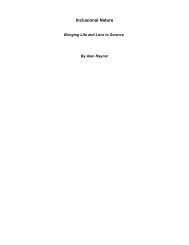JTfM Vol 1 No 1 2008 - ONLINE EDITION - Inclusionality Research
JTfM Vol 1 No 1 2008 - ONLINE EDITION - Inclusionality Research
JTfM Vol 1 No 1 2008 - ONLINE EDITION - Inclusionality Research
You also want an ePaper? Increase the reach of your titles
YUMPU automatically turns print PDFs into web optimized ePapers that Google loves.
Superchannel—Inside and Beyond Superstring<br />
a baryon, they are three together and as meson they are two together both of which constitute<br />
the hadron. There is something disturbing about all this as far as the space-excluding foundations<br />
of the whole of physics is concerned.<br />
At the first encounter, general relativity does not appear to exclude space but as soon<br />
as it is confronted with the question of what it means for a form to flow, it lacks the answer<br />
because things that move in general relativity remain as detached from space as in Newtonian<br />
and quantum mechanics. The apple may fall into the receptive curvature of space rather<br />
than be pulled down directly by a heavier weight as given by Newton but it is still as materially<br />
detached from its spatial context as a billiard ball rolling around a rubber sheet.<br />
Quarks do not come alone. They cannot be separated from what includes them. So if<br />
quarks don’t come alone what happens when an attempt is made to separate them? They pull<br />
away but still remain together. Imagine two things immersed in a pool of water. If you pull<br />
them apart, they still remain pooled together by water, as if by glue. <strong>No</strong>w imagine space serving<br />
the same role as water. In a way quarks are bringing the discrete atomic outlook into<br />
question, suggesting that things are not as they appear superficially and that separateness is<br />
an illusion because the deeper our enquiry reaches, the more we are confronted with the reality<br />
of forms flowing into one another with space included. One wonders how people like<br />
Heraclitus and Wordsworth could reach this understanding of the universe, which transcends<br />
the foundations of classical and modern mathematics and the paradigms of physics without<br />
any of the costly paraphernalia of modern laboratory science? Actually, in a way they were<br />
at an advantage because without that paraphernalia and its accompanying mindset they were<br />
free to enquire simply, as a child might. They could ask themselves questions like ‘what<br />
would the universe look like if it was purely made of space’ and ‘what would it look like if it<br />
was pure matter, containing no space’? Between the answers of formless and a dimensionless<br />
point would come the realization that matter and space can’t be isolated from one a-<br />
nother, but are instead combined in a cosmic dance of energy flow – dynamically transfiguring<br />
space!<br />
To embrace this fundamental truth, however, would mean to abandon the classical outlook,<br />
remodel the relativity outlook and begin all over again the quantum journey in which<br />
the discreteness of quantum is replaced by a distinct but not fully definable dynamic form<br />
that harmonizes within instead of antagonizing its natural, omnipresent source. This is what<br />
an inclusional and transfigural outlook both requires and offers. If this outlook is brought to<br />
bear on the quantum world, quarks would no longer be points, which indeed they are not, but<br />
dynamical forms that by their very nature include some positively responsive aspect within<br />
some negatively receptive aspect. Here positive and negative are not the antagonistic opposites<br />
of collision and exclusion, but the reciprocal complementarities of the communion and<br />
natural inclusion of one in the other.<br />
This brings us to Heraclitus again. Heraclitus' main teaching concerned the "unity of<br />
opposites". Unity of opposites entails one thing being made of two sides which contain one<br />
another in different levels. A day is composed of daytime and night-time in which one is<br />
contained in the other through the day without exhausting it. Another example is the present,<br />
which dynamically includes both past and future. We will return to this later when we explore<br />
the fluid logic numbers of Transfigural Mathematics (TfM) and one of their zero spirals<br />
called the zeroplines.<br />
<strong>No</strong>w to our further exploration of strings:-<br />
A string, being a discrete length, is of the form:<br />
38<br />
Journal of Transfigural Mathematics <strong>Vol</strong>.1 <strong>No</strong>.1.<strong>2008</strong>




